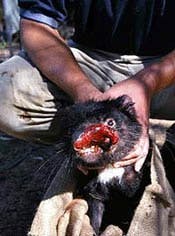Forestry Tasmania has thrown its support behind a statewide water quality audit amid growing calls for an end to aerial spraying of chemicals in catchment areas, the AAP reported.
Doctors for Forests, a conservation group, supports a call by the state branch of the Australian Medical Association to ban the practice.
Dr. Marcus Scammell, a Sydney-based marine ecologist has suggested a link between aerial-borne agricultural and forestry chemicals and large-scale oyster deaths at Georges Bay, St Helens, on the state's east coast, after heavy rains.
According to Dr. Scammell, the problems with oysters also correlated with tumors and mortality in Tasmanian devils, which are being killed off by a mysterious facial cancer.
Evan Rolley managing director of Forestry Tasmania said there was no science-based evidence of such a link to devil disease, but the state forestry body treated the matter very seriously.
"From the point of view of water quality, we took some initiatives 10 years ago to try and put in place international best practice in terms of pre and post measurement after significant rainfall events," Rolley said. "We haven't been spraying in the Georges Bay catchment, so I am not sure what the connection there is to the oysters."
Rolley said that certainly Forestry Tasmania has not been involved in that catchment in aerial spraying. However, water quality is very important to a lot of people. "It is important to Tasmania's image in terms of the quality of the produce we export. So let's have a full and independent audit," he said. "We will support the Director of Public Health in this endeavor and I think everyone should cooperate with that review."
According to Doctors for Forests spokesman Dr Frank Nicklason, any investigation and monitoring of forestry and agricultural related chemical spray residues should be performed by an independent, scientific body.
"Many people in more remote rural areas use creeks and rivers for drinking water for themselves and their livestock," he stated. "The potential for chemical spray residues in drinking water is of such public health importance that only independent, arms-length and scientifically valid monitoring is acceptable."
Source: AAP


